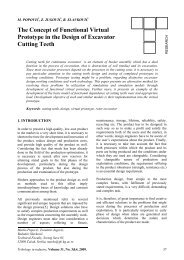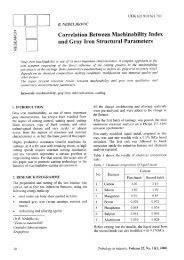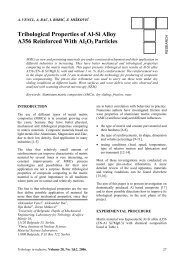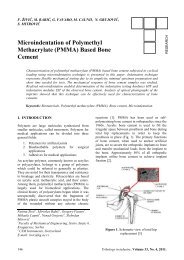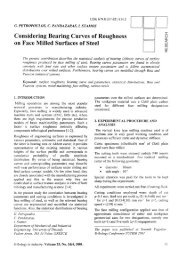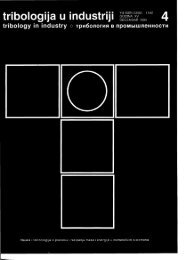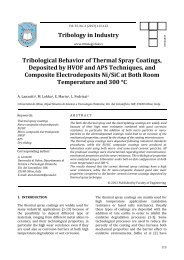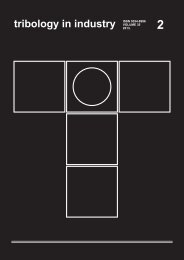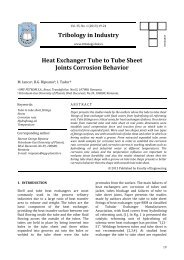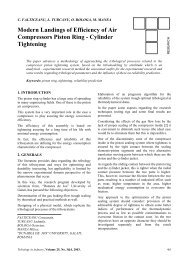No. 4, 1998 - Tribology in Industry
No. 4, 1998 - Tribology in Industry
No. 4, 1998 - Tribology in Industry
Create successful ePaper yourself
Turn your PDF publications into a flip-book with our unique Google optimized e-Paper software.
Distribution of these <strong>in</strong>clusions was studied <strong>in</strong> detail and<br />
described <strong>in</strong> work [9]. Most <strong>in</strong>clusions were observed <strong>in</strong><br />
the mentioned projections of the weld overlay close to<br />
surface while form<strong>in</strong>g whole agglomerates.<br />
The results from the study of samples <strong>in</strong> the zone of two<br />
adjacent projections surface, as the result of roll<strong>in</strong>g process<br />
(relative movement of hot and work<strong>in</strong>g surface of<br />
the roll), can be seen. At greater magnification (Fig. 2,3)<br />
spheroidized carbidic particles, as the result of thermal<br />
impacts <strong>in</strong> roll<strong>in</strong>g and plastic stra<strong>in</strong> of the surface layer,<br />
and also agglomerates of <strong>in</strong>clusions of manganese-silicate<br />
type can be observed,<br />
Thus <strong>in</strong> fnrmation of plastic stra<strong>in</strong> barriers we encounter<br />
two phenomena, namely the presence of carbidic globules<br />
distributed non-uniformly through the weld overlay<br />
thickness and also clusters of <strong>in</strong>clusions of manganesesilicate<br />
type.<br />
Plastic crack stra<strong>in</strong> around the <strong>in</strong>clusions qruses nuclei<br />
which due to cyclic temperature variations grow and<br />
form thermal fatigue craks (Fig.4).<br />
4. SURFACING OF WORKING ROLLS<br />
FOR CONTINUAL CASTING OF SI"ABS<br />
Fig. 2. Plastic defonnation of the surface layer<br />
Fig. 3. Plastic deformation of tlu surface layer<br />
Besides the rolls for form<strong>in</strong>g of metals, also the rolls for<br />
cont<strong>in</strong>ual cast<strong>in</strong>g of slabs are deposited <strong>in</strong> Slovakia. The<br />
work<strong>in</strong>g rolls serve for draw<strong>in</strong>g of slabs, their support and<br />
coll<strong>in</strong>g. Fig. 5 shows the position of the rolls <strong>in</strong> "the<br />
cont<strong>in</strong>ual cast<strong>in</strong>g l<strong>in</strong>e.<br />
The work<strong>in</strong>g rolls are arranged <strong>in</strong> separate sections and<br />
their diameters are graded as follows: A250, 270, 300,<br />
370 and 380 mm, with weight from 800 to 1960 kg.<br />
Material of rolls is forged lowcarbon steel with follow<strong>in</strong>g<br />
chemical composition:<br />
C=0.17 +0.27Vo, Mn=0.3+0.7Vo, 5i - Q,lJ+0,4Vo,<br />
Cr= 1.2 + 1. 6Vo, Mo = 0.25 + 0. 5 Vo, V= 0. 4 + 0.7Vo.<br />
Roll hardness after treatment is 250H8. [7]<br />
In order to prolong their life the rolls are surfaced by use<br />
of SA process with tubular wires <strong>in</strong> comb<strong>in</strong>ation with<br />
fluxes accord<strong>in</strong>g to table 1.<br />
The laboratory tests of weld metals aga<strong>in</strong>st wear from<br />
various tubularwires on the abrasion and on the p<strong>in</strong>-ondisc<br />
mach<strong>in</strong>e are given <strong>in</strong> table 3.<br />
Table 3. The results of wear coeficient, fiction coeficient<br />
and hardness of hardfac<strong>in</strong>g mateials from tubularwires<br />
[7]<br />
.Maqk,of..,<br />
eledffctCe Vaut V.an<br />
'::::<br />
:l: ::: l:::: :::l::::::::: :l::::::<br />
p,Coet,,of<br />
Haidnesq.;<br />
.ifriCtion.;l..'.ltlV'.,..<br />
.' 1,81 6,36 0,386 440<br />
"v,uz..B'2<br />
VUZ;RD531i 1,70 5,08 0.388 314<br />
1.78 5,44 0,388 418<br />
VUzHossC",, 1,62 2,05 0,470 2ffi<br />
1,36 3,57 0,390 280<br />
1,28 1.57 0,580 210<br />
Elalan:l I ED2<br />
1,0 1,0 0,680 175<br />
Fig. 4. Nucbation of tlrc crack<br />
Practical tests of roll life have shown that after production<br />
of" 200 M0 t of slabs, the wear on forged rolls without<br />
surfac<strong>in</strong>g was 6 mm from the roll surface with fatigue<br />
156 Triholog <strong>in</strong> <strong>in</strong>&utry, Volume 20, <strong>No</strong>. 4,<strong>1998</strong>.



